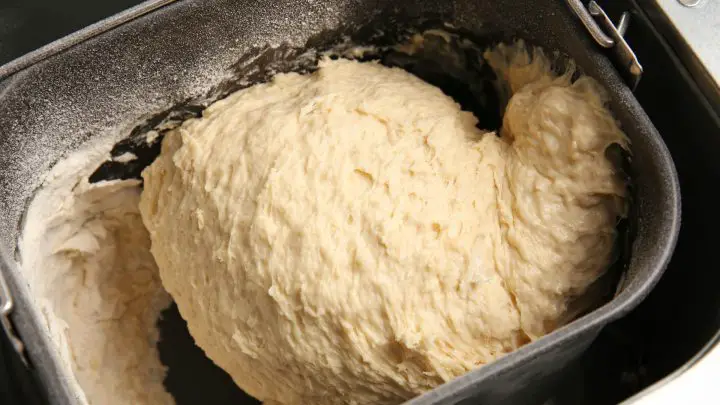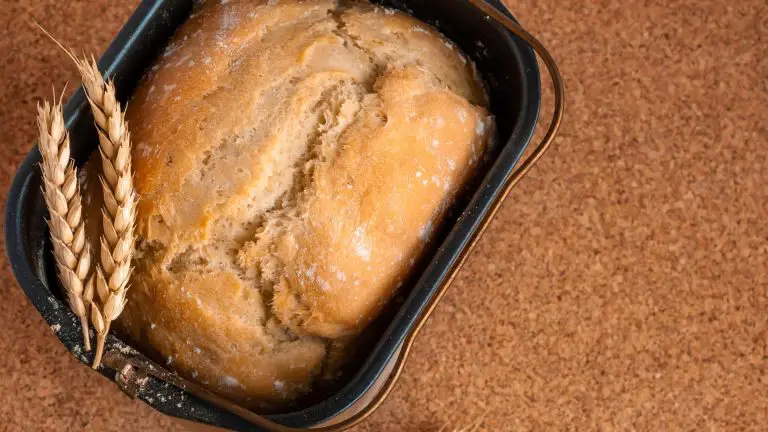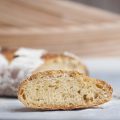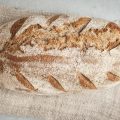If you haven’t heard of a bread machine, then it’s time to invest in one. While making sourdough bread is certainly delicious and rewarding it’s also very time-consuming. The phenomenal results of a perfectly baked sourdough loaf are certainly worth it, but there’s nothing better than pushing a button and wandering off to do something else while the dough is being kneaded for you. Try this scrumptious sourdough bread machine recipe, and you’ll never look back at old-fashioned kneading again!

Table of Contents
- Why Use a Bread Machine to Make Sourdough Bread?
- Bread Machine Sourdough Tips and Tricks
- Bread Machine Sourdough Recipe
- Can I Use My Sourdough Discard in Bread Machine?
- Sourdough Bread Machine – Our Pick!
- Sourdough Bread Machine Recipe – FAQs

Bread Machine Sourdough Recipe
This delicious machine sourdough bread is probably one of the easiest tools for sourdough bread bakers. And your sourdough loaf will emerge just as delicious, if not better!
If you’re unable to hunch over the kitchen counter and knead the dough with pent-up passion, then have no fear, the brilliant sourdough bread machine will gladly take your place!
- Total Time: 8 hrs 50 mins
- Yield: 1 loaf 1x
Ingredients
- 120g sourdough starter
- 180g water
- 360g whole grain dark rye flour, bread flour, or all-purpose flour
- 1 tsp salt
Instructions
- Place the wet and dry ingredients in the bread machine pan and in the order recommended by the bread machine manufacturer.
- Start the dough cycle and let it complete, then let the dough rise for 2 hours using the rise cycle.
- Remove the dough from the bread machine.
- Place the dough on a lightly floured surface and make a smooth ball.
- Line a parchment paper in a Dutch oven and place the dough onto it.
- Cover the Dutch oven with the lid and let the dough rise for 4 hours until it’s about twice in volume.
- Preheat the oven to 450 degrees F. Meanwhile, score the dough with a sharp knife.
- Place the Dutch oven in the oven with the lid on and bake the bread at 400 degrees F for 25 minutes.
- Remove the bread from the oven and place it on a cooling rack.
- Slice the bread with an electric knife or serrated bread knife after it has cooled down completely.
- Prep Time: 8 hrs 5 mins
- Cook Time: 45 mins
- Category: bread
- Cuisine: American
Nutrition
- Calories: 117 kcal
- Fat: 1g
- Saturated Fat: 1g
- Carbohydrates: 24g
- Protein: 4g
Why Use a Bread Machine to Make Sourdough Bread?
A bread machine can be a helpful tool for kneading sourdough bread, especially if you’re short on time, or struggle to stretch and fold the bread dough due to any type of medical condition. Many bakers who suffer from medical conditions aren’t always able to use their hands for meticulous tasks like kneading bread. Therefore, a stand mixer is used to help knead the dough.
While the process of gently stretching and folding sourdough helps develop strong gluten, kneading in a bread machine will certainly speed up the process. Most bread machines are also great at handling higher hydration dough since you won’t have to worry about the dough sticking to your fingers, and you can happily enjoy your delicious bread – hassle-free!
Benefits of Using a Bread Machine
Using a bread machine for sourdough bread will not only make your life easier but it can also:
- Help to speed up the kneading process
- Produce appropriate development of gluten
- Doesn’t require physical touch for kneading
- Easily handle higher hydration dough
Bread Machine Sourdough Tips and Tricks
If you’re not accustomed to using a bread machine for sourdough recipes then you may find that it can take a few attempts before you achieve perfection.
Here are some tips and tricks that’ll help you bake great sourdough bread.
- Firstly, the amount of water you use is extremely important. This will determine the texture of your bread. Generally, the higher the hydration, the airier and fluffier the sourdough bread will be. If you’re a fan of air sourdough bread, then you might want to keep your dough at 75% hydration.
- This is entirely optional, but for an additional softened texture, try adding some softened butter to your sourdough bread machine recipe. However, you may find that your crust isn’t as crisp as one without butter.
- A sprinkle of sugar or a dribble of honey will not only sweeten your loaf but provides an incredibly browned crust. This is extremely important as most bread bakers are unable to mimic the oven temperatures that you may find in a bakery, resulting in an even less browned crust, which can be a bit disappointing.
- Before baking, sprinkle a tiny bit of flour atop your dough and score it from top to middle. This gives your bread a wonderful authentic feature, and more importantly, it helps your bread rise wonderfully.
Bread Machine Sourdough Recipe
This delicious machine sourdough bread is probably one of the easiest tools for sourdough bread bakers. And your sourdough loaf will emerge just as delicious, if not better!
If you’re unable to hunch over the kitchen counter and knead the dough with pent-up passion, then have no fear, the brilliant sourdough bread machine will gladly take your place!
- Type: Bread
- Cuisine: American
- Recipe yield: 1 loaf
- Calories: 117kcal
- Prep time: 5 minutes
- Cooking time: 45 minutes
- Kneading and rising time: 8 hours
- Total time: 8 hours 50 minutes
Ingredients
- 120g sourdough starter
- 180g water
- 360g whole grain dark rye flour, bread flour, or all-purpose flour
- 1 tsp. salt
Instructions
- Place the wet and dry ingredients in the bread machine pan and in the order recommended by the bread machine manufacturer.
- Start the dough cycle and let it complete, then let the dough rise for 2 hours using the rise cycle.
- Remove the dough from the bread machine.
- Place the dough on a lightly floured surface and make a smooth ball.
- Line a parchment paper in a Dutch oven and place the dough onto it.
- Cover the Dutch oven with the lid and let the dough rise for 4 hours until it’s about twice in volume.
- Preheat the oven to 450 degrees F. Meanwhile, score the dough with a sharp knife.
- Place the Dutch oven in the oven with the lid on and bake the bread at 400 degrees F for 25 minutes.
- Remove the bread from the oven and place it on a cooling rack.
- Slice the bread with an electric knife or serrated bread knife after it has cooled down completely.
Nutrition
- Calories: 117kcal
- Carbohydrates: 24g
- Protein: 4g
- Fat: 1g
- Saturated fat: 1g
Can I Use My Sourdough Discard in Bread Machine?
You can certainly use your sourdough discard, for baking bread in a bread machine. In fact, you’ll probably achieve scrumptious results at the end of it!
If you loved baking with a sourdough starter, then why not try baking with your discard? Simply add your discard to the bread machine, along with the rest of your ingredients. Then let the bread machine work its magic!
Sourdough Bread Machine – Our Pick!
The bread machine is an incredible tool to have in your kitchen, alongside the Dutch oven, and dough mixer of course!
I used rye flour in this recipe, so you might like these rye sourdoughs on my blog as well:
Sourdough Bread Machine Recipe – FAQs
How Does Sourdough Rise Without Yeast?
Contrary to what many may believe, sourdough most certainly does not rise without yeast, just like regular bread dough. The difference is, that sourdough does not require commercial yeast to rise, but rather a natural culture of wild yeasts and good bacteria, otherwise known as the sourdough starter.
This sourdough starter is quite literally a living breathing organism, that resides on your kitchen counter, requiring regular feedings to remain alive and healthy. The naturally occurring yeasts in the sourdough starter feed on the flour and water to create carbon dioxide gas. This also creates air bubbles in your sourdough bread recipe.
You will require a strong gluten network so that the dough is able to maintain the gas bubbles produced by the sourdough yeast.
How Much Should I Feed My Sourdough Starter?
When it comes to feeding your sourdough starter, the simplest way of feeding it is to combine equal weights of starter, with flour and water.
The night before baking, reserve 60g of sourdough starter, then proceed to mix in 60g of fresh wholegrain rye flour and 60g of water. The next morning you should have 180g of sourdough starter all ready for you.
Then simply measure out 120g for the bread, 20g to feed, and discard the remainder. Finally, feed the remaining 20g of sourdough starter with 20g of flour and 20g of water.
What is The Best Flour to Feed My Sourdough Starter?
When it comes to choosing the best flour for your starter, you should aim for the most nutritious flour i.e., whole wheat or rye flour. This is so that it can supply a good amount of nutrients for your yeast and bacteria to flourish, as well as produce wonderfully flavored sourdough loaves.
Can You Use A Bread Machine To Make A Whole Wheat Sandwich Bread?
Absolutely, and why not? Simply swap your regular flour for wheat flour, and toss the ingredients into the machine and let the bread maker work its magic! The bread machine is great for baking basic sourdough bread, but if you’re looking for something a little more healthy and flavorful, then you can certainly experiment with a variety of flour.
You can even sweeten the no-yeast sourdough bread with a smidge of granulated sugar, honey, or even maple syrup. I like to add this in with my main ingredients so that it blends with the smooth beautifully.





![Homemade Sourdough Baguette [Try It!] 85 Homemade sourdough baguette [try it! ]](https://www.mydailysourdoughbread.com/wp-content/uploads/2022/09/Homemade-sourdough-baguette-scaled-120x120.jpg)

